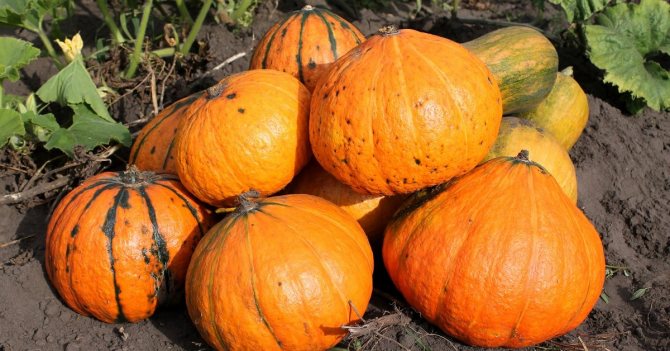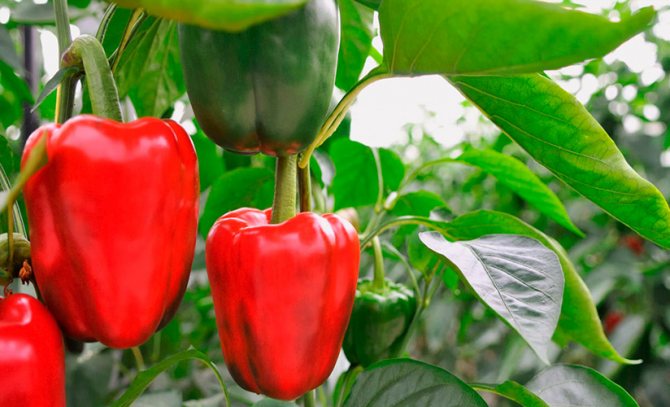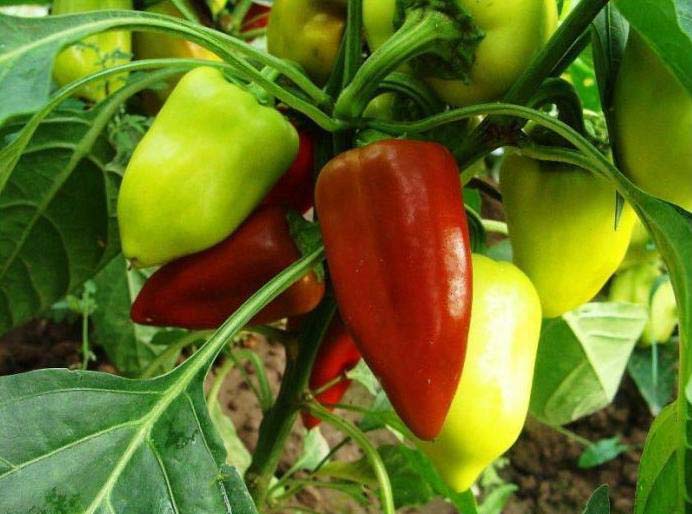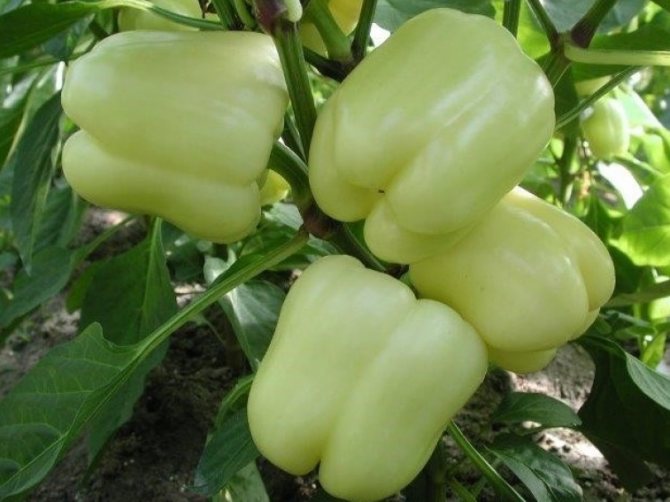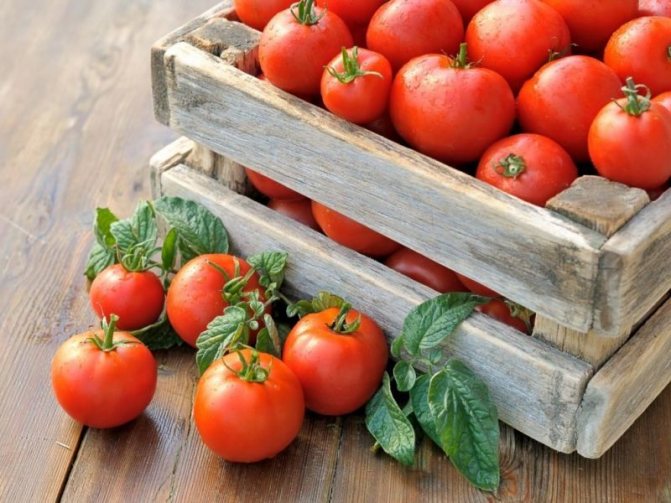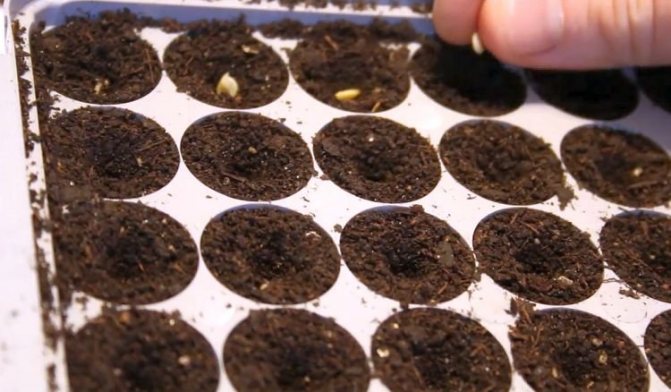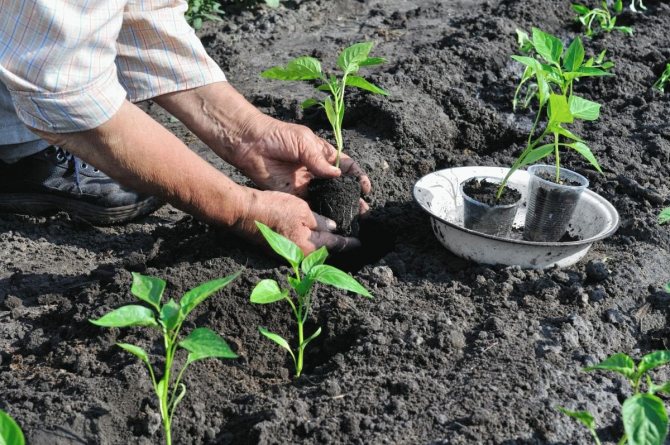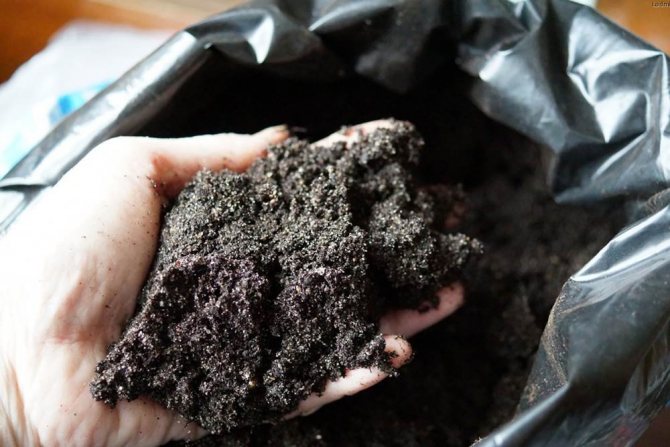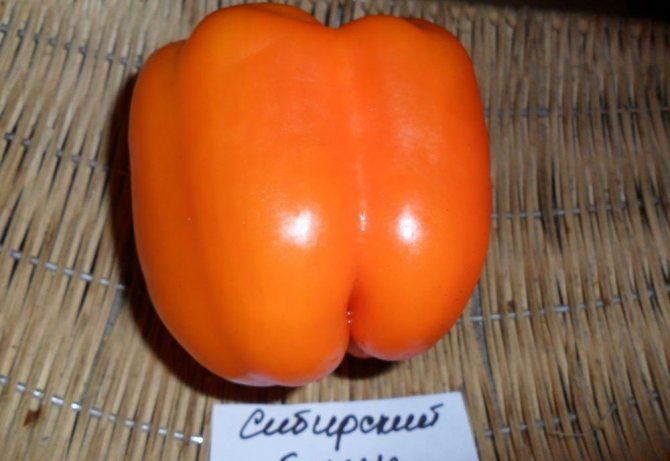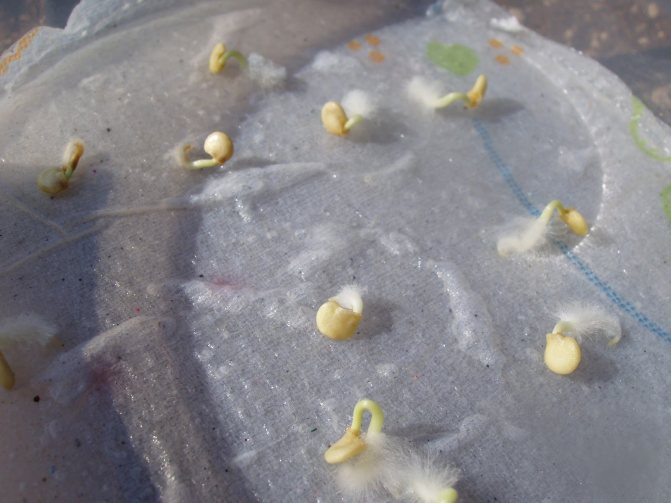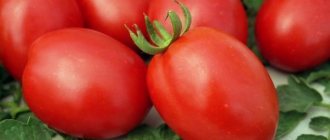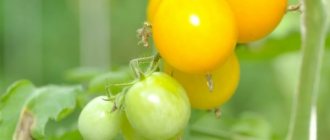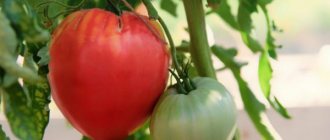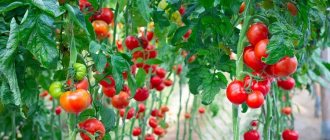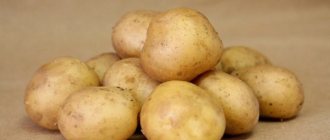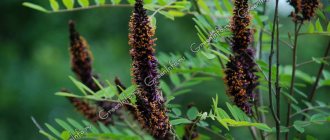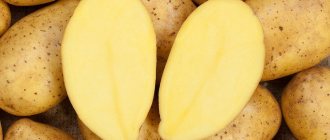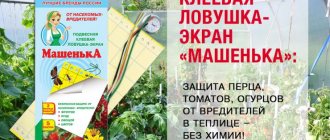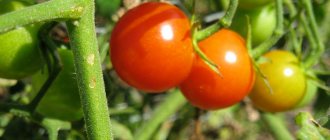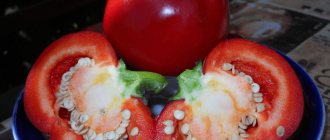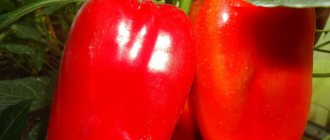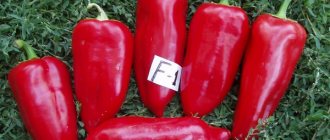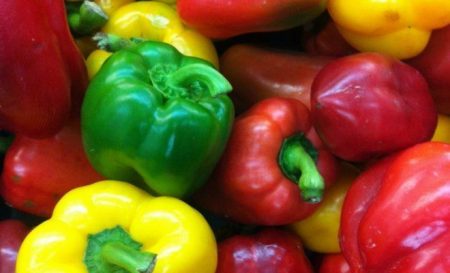
Among the various varieties, as well as hybrid forms of this culture, thick-walled sweet peppers are especially popular with gardeners. They are best suited for preparing salads, and many also use such fruits for stuffing, freezing. Growing such peppers is beneficial, although it requires knowledge of some of the features of agricultural technology. But the most important thing is to choose the right variety: in terms of ripening, in taste.
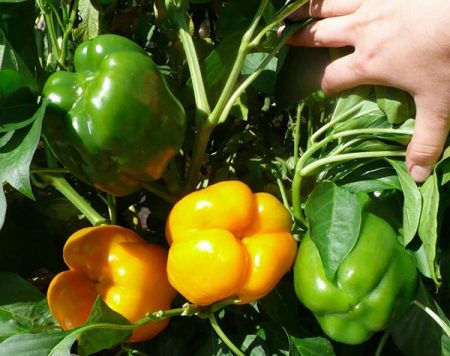

Today gardeners can buy thick-walled pepper seeds from a wide variety of manufacturers. Many varieties, hybrids have been bred, which have proven themselves in various regions of the Russian Federation, including in areas with a difficult climate. Our review presents peppers that can be grown in the Moscow region, as well as thick-walled varieties bred by Siberian breeders.
As you know, thick-walled peppers are fruits in which the pericarp is over 6 mm thick. The shape of the peppers, as well as the color, can be very diverse, so it will not be difficult to find fruits in cones, prisms or barrels.
Harvest varieties of Siberian peppers
For several years now, work has been underway to develop varieties of vegetable crops that have all the qualities for successful cultivation in areas with difficult climatic conditions. Peppers of Siberian selection, resistant to adverse conditions and high-yielding even in the northern regions, have earned great popularity among experienced gardeners.
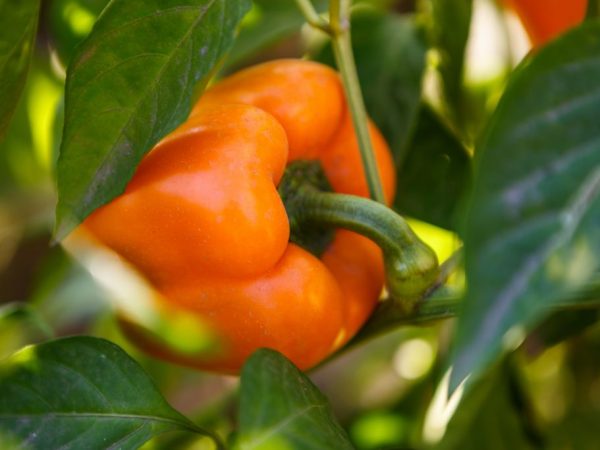

Harvest varieties of Siberian peppers
Siberian format: video
One of the defining characteristics of the sweet pepper variety is the thickness of the pericarp (pericarp). It is this part of the plant that is eaten. The thicker the fruit wall, the more profitable the cultivation of this or that variety. Thick-walled varieties are considered to be with a pericarp thickness of 6 mm and above.
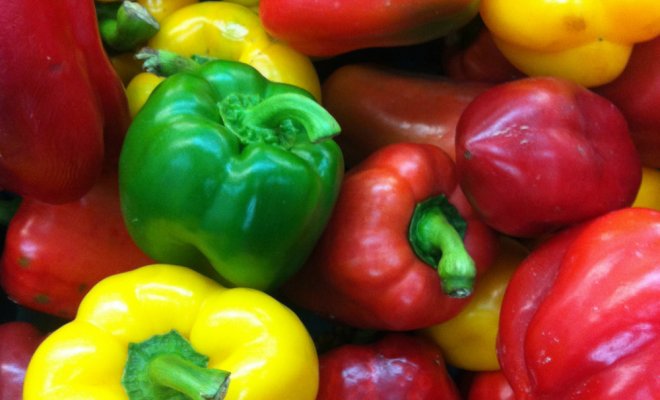

Varieties of thick-walled sweet peppers for open ground
Contents of step-by-step instructions:
Early varieties of Siberian selection
There is a large number of high-yielding peppers of the Siberian collection among the early maturing ones. They mature in a short, cool summer.
Valentine F1
Valentine is an early hybrid with high yields. The fruits can be harvested in 105-115 days.
According to the description, the bushes are undersized, reaching a height of 35 cm. This compactness makes it easier to care for the plants, and also allows you to grow more bushes in a limited area. For 1 sq. m planted up to 8 plants. The variety is suitable for compacting plantings of indeterminate peppers. The bush is covered with large leaves of deep green color with slight wrinkles.
The bushes grow up to 20 small fruits directed upwards.
Fruit
The fruits differ in a number of characteristics:
- elongated conical shape;
- dense shiny skin;
- weighing 50-90 g;
- walls 0.6-0.8 cm thick;
- dark red.
Valentine F1 has a high content of vitamin C-175 mg and glucose, fructose - about 3.2%.
Novosibirsk
Novosibirsk is an early maturing variety of Siberian selection. The fruits reach technical maturity in 92-110 days from the moment of mass germination of seeds. It is suitable for outdoor cultivation.
The bush is medium-sized, up to 0.9 m high. Powerful, with compact arrangement of branches, erect.On the bushes, 15-20 fruits of equal size with high commercial qualities are tied.
Fruit
The fruits have the following characteristics:
- conical truncated shape;
- smooth, shiny skin;
- wall thickness 5-6 mm;
- weight 100-120 g.
Novosibirsk has excellent yield indicators: from 1 sq. m collect 7-10 kg of high quality fruit.
You can increase the yield of the variety and increase the size of the peppers by growing the crop by forming a bush in 2 main stems. Also, this variety responds well to regular feeding and processing with special growth stimulants.
Siberian prince
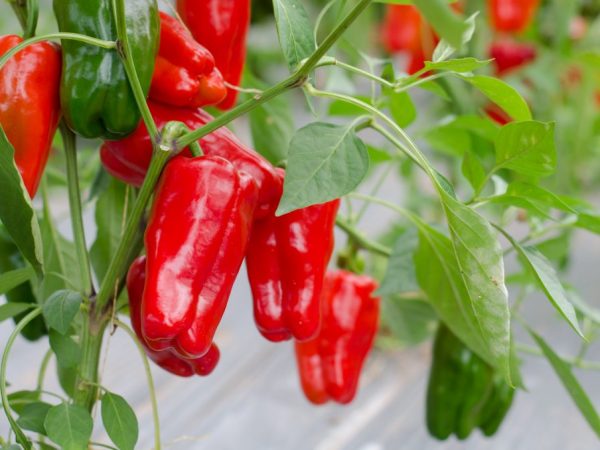

The fruits are versatile in use
The Siberian Prince is an early variety, fruitful, with high resistance to adverse weather conditions. Fruits ripen together, evenly after 115-125 days from the moment of emergence. From 1 sq. m, about 5 kg of vegetables are harvested. The variety is suitable for planting in open beds, film tunnels and greenhouses.
The bush of the variety is medium-sized, with a dense deciduous mass. The stems are resistant to mechanical pressure, the elastic branches return to an upright position when the excess fruit is removed.
Fruit
- conical, aligned shape;
- three-, four-chamber;
- surface with a glossy sheen;
- walls 4.5-5 mm;
- weighing up to 150 g;
- color from yellow to red.
The pulp is sweet, firm, crunchy, with a pleasant taste. The fruits are suitable for preservation, salads and drying.
Seeds for seedlings are sown at the end of February, and young plants are transplanted to a permanent place 70-75 days after the threat of frost has passed. Seedlings are planted adhering to the 60 x 40 cm scheme. The variety grows well on loamy drained soils.
Siberian bonus
Siberian bonus is a high-yielding early representative of Siberian selection.
Bushes
Bushes are medium-sized, up to 85 cm, compact, have limited branching. 10-15 fruits are tied on one bush. They begin to ripen 65-70 days after the seedlings are planted in the soil.
Fruit
The fruits have the following characteristics:
- cubic shape;
- smooth, shiny surface;
- the thickness of the mesocarp - 8-12 mm;
- weight - up to 300 g;
- color orange-red, orange.
The pulp is crispy, does not contain capsaicin, therefore it is sweet even in technical maturity.
In a state of technical maturity, the yield reaches 3-3.5 kg per bush. It ripens well already in the assembled state, does not lose its elasticity.
Culinary uses, advantages and disadvantages of culture
These peppers are versatile. They are stuffed, crumbled into summer and canned salads, used for various sauces and snacks, stored in the freezer. However, the best way to use an early vegetable is fresh consumption.
Experts attribute the following characteristics to the advantages of pepper:
- Early maturity. Under optimal conditions, the variety is even capable of producing an early harvest.
- Stable high yield. The originator is limited only to such a description and does not provide precise information.
- Large-fruited.
- Thickness.
- Good juicy taste. The increased content of vitamin C.
- Resistance to bad cold weather, lack of sunlight and diseases associated with these negative factors. Pepper does not reduce the rate of fruiting during unfavorable periods of summer.
Attention! Due to the latter quality, the hybrid is recommended for planting in the conditions of the Urals, Siberia, the North-West region, the Far East and Primorye.
Cons of sweet peppers:
- hybrid nature - the culture is not available for seed propagation;
- lack of resistance to a number of diseases.
Mid-season peppers of Siberian selection
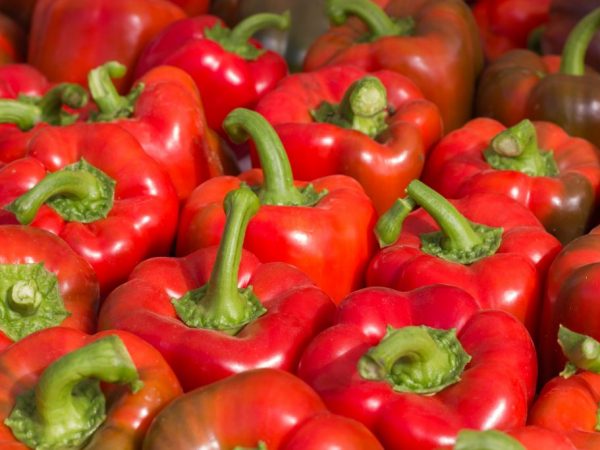

Varieties will delight you with high yields
The ripening period of medium varieties is about 130-145 days. Mid-season peppers are thick-walled and high-yielding.Siberian breeders have developed a number of mid-season varieties with high quality indicators.
Zest
Zest - bell pepper with an average ripening period. Fruits begin to ripen in 130-140 days from the moment of sowing seeds for seedlings. They are suitable for growing outdoors in Siberia and other regions.
The variety is resistant to various diseases, well adapted to low temperatures and lack of lighting.
Standard type bush. Height - 55-70 cm. The bush is medium-branched, which makes it compact, does not require tying and shaping. 8-12 peppers are formed on each plant.
Fruit
The fruits of the plant have a number of characteristics:
- cylindrical shape;
- the surface is glossy, smooth;
- weight 160-180 g;
- walls 7-9 mm;
- deep yellow color.
The fruits have a pleasant taste and rich aroma, which remains even after heat treatment.
Bagheera
It is a high-yielding mid-season variety with large fruits. Bagheera peppers begin to ripen in 140-145 days from the date of sowing seeds for seedlings.
The culture is grown by seedling method. In order for the peppers to ripen in the open field, the seeds are sown on the 10th of February.
Semi-spreading bushes, undersized up to 55 cm high. Leaves are oval-pointed, green, medium-sized. 6-8 wilted fruits are formed on the bushes during the season.
Fruit
Fruits are characterized by a number of characteristics:
- cubic shape, four-chamber;
- the surface is smooth, shiny;
- the walls are thick, up to 0.9 cm;
- weight up to 320 g;
- color from violet-black to red.
Their pulp is very juicy and aromatic. At the stage of technical maturity, there is a slight spicy note on the palate, the fully ripe fruit is sweet and very pleasant to the taste.
The best variety "Lumina"
This type of pepper is considered the most common among others. The bush does not grow tall, and the mass of one pepper does not exceed 115 grams. It is distinguished from the previous variety by a slightly golden color or light green with a slight shade of pink. The shape of the pepper is conical, and the wall thickness of the pepper is 6 mm on average. It does not give a bright pronounced aroma, but it tastes sweet with an admixture of water.
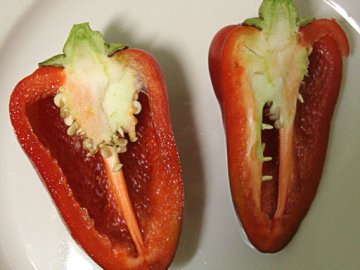

"Lumina" - this variety is grown more often than others by gardeners due to its unpretentiousness to the soil. The store also sells it most often. This variety of pepper grows well even in dry summers; frequent watering is not required. But sometimes such care of peppers leads to the fact that they are obtained with a taste of light bitterness and a pungent taste. As for the preservation of pepper, it can retain its taste and appearance for 3 months.
Late-ripening varieties of Siberian selection
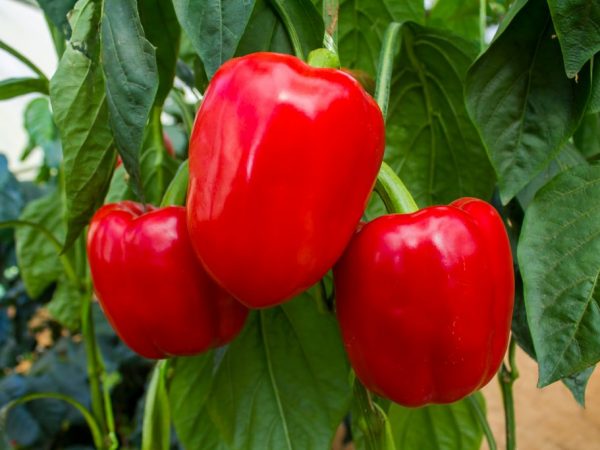

The ripening period of fruits depends on the region
The ripening period of varieties of Siberian peppers of the late-ripening category is about 150-155 days from the moment the seeds are planted in the soil.
Marshmallow in chocolate
Marshmallow in chocolate is a unique variety of the Siberian collection, which differs from others in color and sweetness. It belongs to the middle late peppers, which are suitable for greenhouses and open beds. The ripening period of the pepper depends on the region in which the crop is grown. In the southern regions (Krasnodar Territory), fruits appear earlier. In the northern regions, fruiting can be delayed by 15-25 days.
The variety shows complex resistance to fungal and viral diseases of nightshade crops.
The bushes are medium-sized, 65-85 cm high, powerful, with a well-developed root system and a strong central shoot. Due to the large number of peppers being tied, the bush requires a garter to the stakes.
Fruit
- clear edges;
- three-chamber;
- thin, delicate skin;
- thick, more than 9 mm walls;
- weighing 180-250 g;
- chocolate brown.
The high sugar content and juiciness make the Marshmallow in chocolate ideal for fresh consumption.The variety is suitable for various types of culinary processing, but it must be borne in mind that when exposed to heat, it loses its beautiful color.
The variety has high transportability and keeping quality.
hippopotamus
The hippopotamus is designed for a different cultivation method. It is a stress-resistant variety with good adaptability to cold temperatures. With temperature changes, the variety does not throw off flowers and does not stop growing fruits. Peppers begin to ripen in 120-130 days from the moment of seed germination.
The bushes are semi-spreading, medium-sized, up to 0.9-1 m high. 10-15 homogeneous fruits are formed on one bush.
For greenhouses
Planting in a greenhouse allows you to neutralize the vagaries of the weather, therefore, in Siberia, this method of cultivating pepper is popular:
- Korenovsky. Mid-season. Semi-spreading bush, 55–65 cm high. Fruits in the form of a truncated cone or prism, ribbed, of different sizes (69–160 g), red. Wall thickness - 4.6–4.7 mm. Productivity - 1.9-4.2 kg / m². Often infected with verticillium.
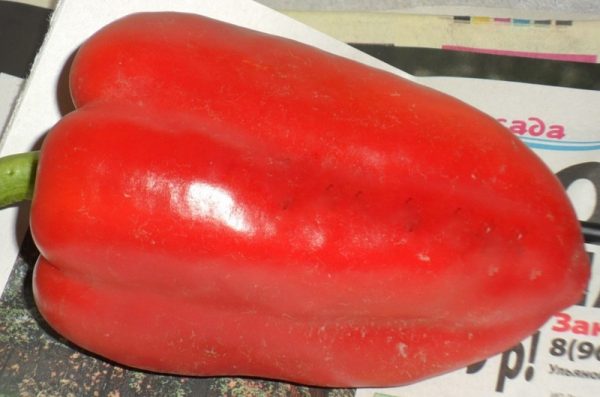

When growing peppers of the Korenovsky variety, it is necessary to pay special attention to the prevention of verticillium - Atlant. Mid-season. The bush is high (1 m or more), spreading. Fruits are conical, with 3–4 nests, one-dimensional (180–190 g), scarlet. The walls are thin (4.1–5.2 mm). The taste is excellent. Productivity - 3.1-3.3 kg / m².
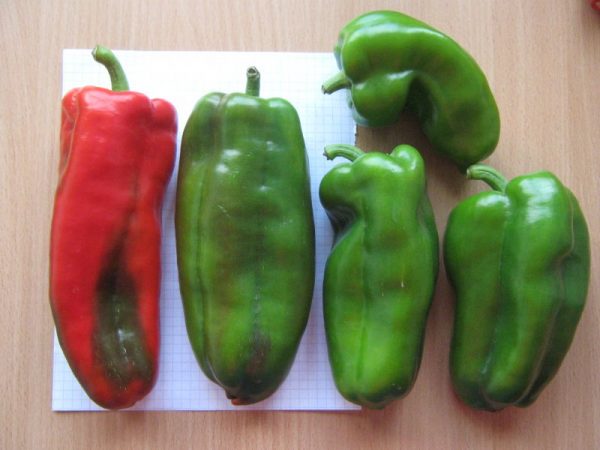

Pepper varieties Atlant are fairly large plants, it is imperative that the planting scheme is observed - Hercules. Late maturing. The bush is medium-sized, semi-wild. Fruits in the form of a cube, glossy, bright red, with 3-4 nests, about the same weight (150-160 g). Walls up to 6.8 mm thick. It is immune to fusarium. Productivity - 2.6 kg / m².
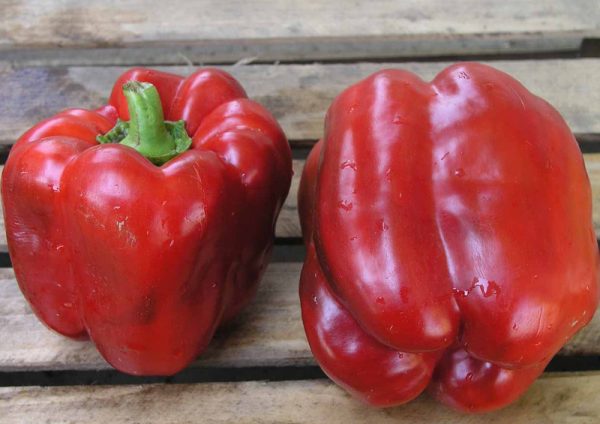

Hercules is a late-ripening pepper, so in Siberia it is only suitable for planting in greenhouses
One of the main purposes of the greenhouse is to get an early harvest. After all, you can plant peppers in it a week or two earlier than in open ground. And if you also pick up early varieties, then the first peppers can be collected not at the end of summer, as usual, but already in its middle.
DETAILS: Pickled cabbage with beets and carrots - 116 step-by-step recipes with photos
Peppers are grown in greenhouses if the region is characterized by frequent heavy rains, droughts, fogs and sudden changes in weather. The greenhouse protects the bushes from adverse factors, maintains the microclimate necessary for development.
Experienced gardeners recommend paying attention to the following thick-walled varieties for greenhouses:
- The Knyaz Silver variety ripens in 110-120 days from the moment of planting, it is distinguished by smooth red-yellow fruits with sweet pulp.
- Hercules - it is characterized by large weighty fruits and compact half-meter bushes that need a garter.
- Arsenal - the variety ripens in 100-110 days. Fruits are elongated, weight - about 120 g. Resistant to diseases.
- Golden Tamara. The variety is characterized by very large fruits, the weight of one is about 200 g. Walls are about 9 mm.
- Claudio f1 ripens in 120-130 days, the weight of one pepper is about 250 g. The bushes are powerful, erect, 50-70 cm high.
The best peppers for Siberia
The harsh continental climate of Siberia negatively affects thermophilic crops. This region requires varieties of peppers that are adapted to difficult growing conditions, which breeders have been working on for many years. Many hybrids and varieties of sweet peppers have been developed, which, subject to agricultural technology, bring fairly good yields. Usually these are crops of the early and mid-early ripening period.
Sowing seeds begins in February. Pepper seedlings will be ready in 2 months. Plants are most often planted in greenhouses and after 95–120 days, depending on the variety, the first crop is harvested. Usually early crops yield up to 4 kg of fruit with 1 m 2 and a pulp thickness of about 6 mm. However, there are hybrids that produce fleshy peppers with a wall thickness of 10 mm.
The video shows a selection of pepper varieties for cold climates:
It's time to move on to a smooth review of early peppers, but first I would like to consider two popular varieties that are considered the Siberian standard.
Gingerbread man
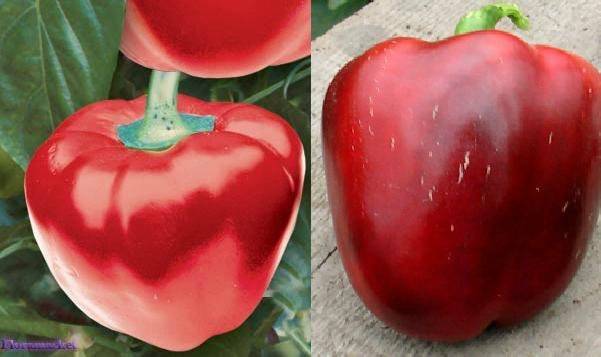

The culture of Moldovan breeders has perfectly adapted to Siberian conditions. An early variety of pepper bears excellent fruit in open beds and under a film cover. The plant has a low-growing bush that is easy to care for. Three- and four-chambered fruits have a delicate red flesh with a thickness of about 9 mm. The maximum weight of one pepper is 90 g. The vegetable is considered to be of universal use.
Topolin
The plant can be formed with two stems, the result of which is a tall shrub that requires a garter to the trellis. With conventional molding, a medium-sized bush grows, which is grown without being tied up in a standard form. The first harvest can be removed after 110 days from the moment the seedlings germinate. Green peppers turn red as they ripen. The fruits are not fleshy with thin walls and weigh a maximum of 150 g. If measured on a large scale, about 50 tons of harvest can be harvested from 1 hectare, which is 5 kg / 1 m 2.
Harvest delicious peppers
This category includes varieties with the best flavor characteristics of the fruit.
Tusk
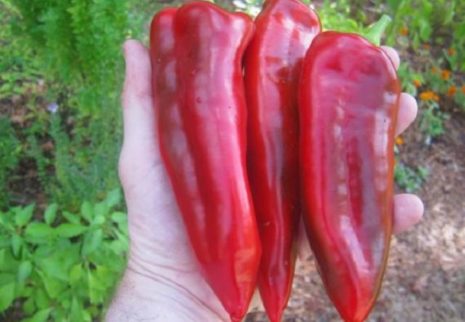

The bushes of the plant are tall, up to 1.4 m, they need support. Early ripe peppers. Their color changes from light green to red. It is a high-yielding crop. The weight of each fruit is 150 grams, they are distinguished by their fleshy pulp and pleasant taste.
Siberian prince
Early maturing variety. The developmental period lasts 114 days. It is grown both in greenhouses and under shelters. Mature bushes have large branches.
The cone-shaped fruit weighs 150 grams. The walls are only 5 mm thick, so the pods cannot be called fleshy. Housewives love this variety for its unusual aroma.
Siberian format
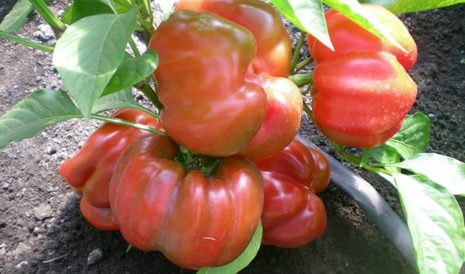

Bred by local breeders. This is a mid-early hybrid. The fruits consist of 3-4 seed chambers. Their color changes from green to bright red. Each bush yields up to 15 pods. If the soil is well fertilized, the weight of the peppers can reach 450 grams. But on open ridges this is not possible. The variety needs feeding and normal humidity.
Overview of early varieties
Now let's get down to an overview of the early peppers. This does not mean that they are worse than those considered above, they simply singled out the first two cultures as the most famous.
Novosibirsk
An early ripening variety of peppers was bred for cultivation in the botanical garden of Siberia. Seeds sown in February produce mature seedlings after 2 months, which can be transplanted into a greenhouse. After 95 days, the first peppercorns ripen. As for the yield, about 4 kg of fruit can be obtained from 1 m 2. The bushes grow up to 1 m high, producing peppers weighing up to 58 g with aromatic red pulp 6 mm thick.
Earlier miracle
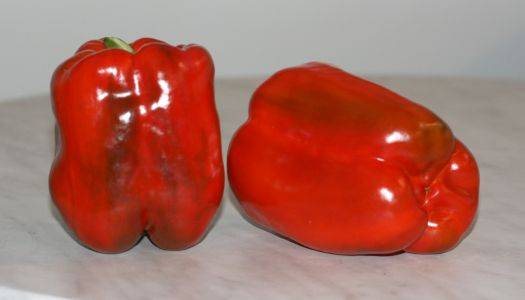

The culture belongs to the early fruiting period. Ripe fruits can be obtained after 90-105 days from the moment the seedlings germinate. The plant is endowed with immunity to viral diseases. The bush can grow up to 1.2 m in height, which requires a garter of branches. When ripe, the peppers turn red.
Montero
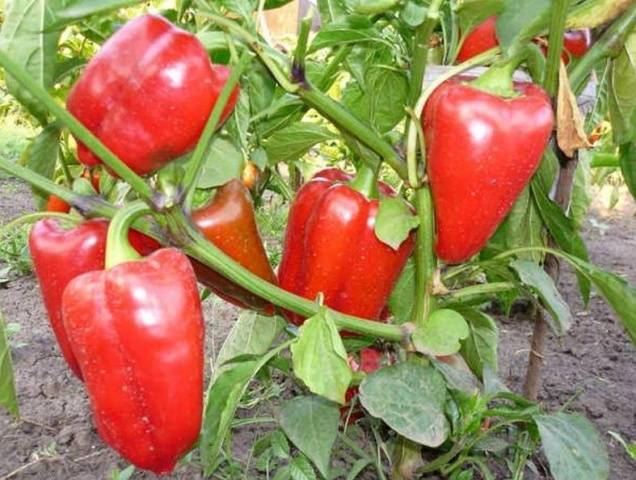

Another tall plant up to 1.2 m in height is suitable for growing in all types of greenhouses. The fruits are very large with a flesh thickness of 7 mm and weigh about 260 g. With good feeding, it was possible to grow giant peppers weighing 940 g. The value of the vegetable is excellent taste. The variety is considered high-yielding, since 7-6 kg of fruit can be harvested from 1 m 2.
Merchant
A very early ripening variety brings its first harvest 80 days after the first shoots appear. Small-sized fruits weigh a maximum of 70 g. As they ripen, the 7 mm thick pulp turns red with a high content of vitamin C. The yield is average, from 1 m 2 you can get up to 3 kg of vegetables.
Pioneer
The variety was bred back in 1987 by Ukrainian breeders. The culture has adapted to the Siberian climate and can be grown even in the Urals.The yield is very low, it is only 800 g per 1 m 2, but the plant bears fruit in the open field without any problems. Small cone-shaped peppercorns weighing 55 g grow on a bush up to 70 cm high. The flesh is red, 4 mm thick. The first crop can be obtained after 116 days from the moment the seedlings are planted.
Winnie the Pooh
A low-growing plant has a maximum bush height of 30 cm. The first harvest can be obtained 110 days after germination of the seedlings. Small cone-shaped peppercorns ripen amicably, and on the bush they are grouped in a bouquet.
Firstborn of Siberia
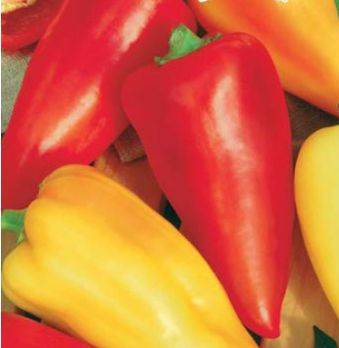

The fact that this is an early Siberian variety is indicated by its very name. The first ripe fruits can be obtained in 100 days. West Siberian breeders have endowed the plant with immunity to viral diseases. According to its characteristics, the culture is similar to the varieties of peppers "Novosibirsk", "Sibiryak and" Victoria ".
Donetsk early
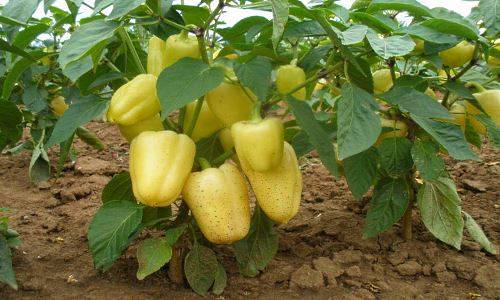

A low-growing plant brings its first harvests after 120 days from the moment the shoots germinate. Cone-shaped peppercorns have a rounded top. The plant can withstand sudden changes in the weather without fear of fungal diseases. According to the characteristics of the fruit, the variety is similar to "Topolin" and "Kolobok".
Dandy
The variety is a novelty developed by West Siberian breeders. The medium-high bush bears bright yellow barrel-shaped fruits. Large peppers weigh about 200 g, while their flesh is 7 mm thick. The vegetable has an excellent presentation.
Triton
The culture is able to bring an early harvest after 85–90 days from the moment the seedlings germinate. Low-growing bushes 45 cm high are very productive. About 10 kg of vegetables can be obtained from 1 m 2, and each bush forms up to 50 ovaries during the entire fruiting period. The mass of the peppercorns is about 150 g, while the thickness of their walls is 5 mm. As it ripens, the color of the flesh changes from green to red.
Characteristics of culture
Sweet early peppers are an annual crop related to the nightshade. There are more than 2,000 species in the world.
Sweet peppers contain large amounts of vitamins and minerals vital for humans.
It includes:
- a record content of ascorbic acid (vitamin C) for vegetables: it helps to strengthen immunity and cleanse blood vessels from cholesterol deposits;
- vitamin P, which increases the elasticity of blood vessels;
- B vitamins, which have a positive effect on the condition of hair, skin, and improve mood;
- iron, which improves blood composition;
- iodine, which normalizes metabolism, stimulates brain activity;
- silicon that strengthens hair and nails.
Pepper selection rules
The short duration of warm days in Siberia severely limits the selection of suitable sweet pepper varieties. When choosing seeds, you need to pay attention to the early maturity of the vegetable. Late ripening culture will not have time to mature even in a greenhouse.
When choosing seeds between varietal peppers and hybrids, you need to know that each of the crops requires different care. For example, the agricultural technology of hybrids is a little more complicated. Here you will need to observe the exact temperature regime, plus apply top dressing in a timely manner. However, the yield and quality of the fruit of the hybrids comes first. If all conditions are met, peppercorns weighing more than 400 g can be grown.
In the professional cultivation of peppers, attention should be paid to imported hybrids. They bear large fruits with thick walls. Also, varieties must be selected according to the shape and color of the fruit.
How to choose the right variety?
The Siberian summer is very short, so not every variety will be able to take root in this region. The main criterion for the selection of planting material is the timing of fruit ripening. Late-ripening crops simply do not have time to ripen before the onset of cold weather.
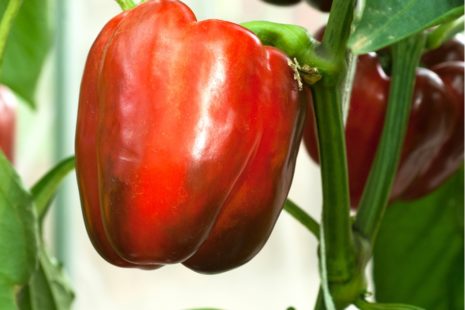

So which is better to choose, hybrids or pure varieties? It must be remembered that these cultures are cared for in different ways. Growing hybrids is difficult.They are sensitive to temperature fluctuations and require high-quality feeding. The most important qualities of hybrids are yield and fruit characteristics. Observing all agricultural techniques, you can get vegetables with a mass of 0.4 kg.
Early peppers can bear fruit in open beds, but maximum yields are achieved in greenhouses.
For those who grow sweet peppers professionally, it is advisable to take a closer look at foreign varieties. The shape and color of the pods must also be taken into account.
Brief overview of hybrids
So, we have considered some varieties, it is time to pay attention to several hybrids popular in Siberia.
F1 White Lady
A compact, small bush bears strong, large cuboid fruits. When ripe, the pepper color changes from white to orange.
Claudio F1
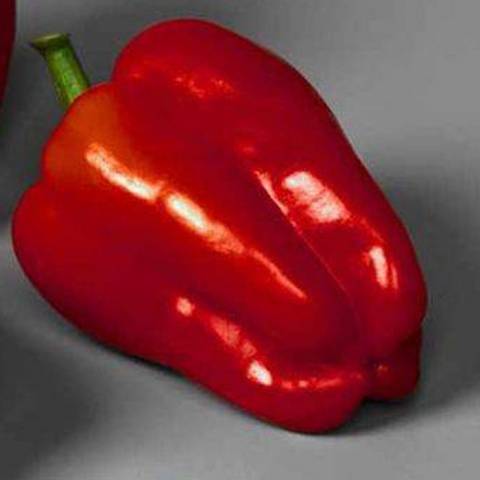

In a maximum of 80 days, the hybrid will give a ripe crop of peppers. The red cuboid fruits weigh about 250 g and have dense juicy flesh. The hybrid is resistant to weather changes and many diseases.
Varieties of different ripening periods
If a gardener has just started growing vegetables, especially in a cold region, it will be difficult for him to find the right variety right away. Therefore, we list the popular peppers that ripen early or mid-term.
- Gingerbread man. Produces compact, green, upward-directed fruits.
- Topolin. The most famous in Siberia. The weight of the pods is 150 g.
- Montero is a large-fruited universal variety.
- One. A good option for beginners. Adapts to any climate.
- Selvia is a yellow variety with beautiful fruits. It tastes great.
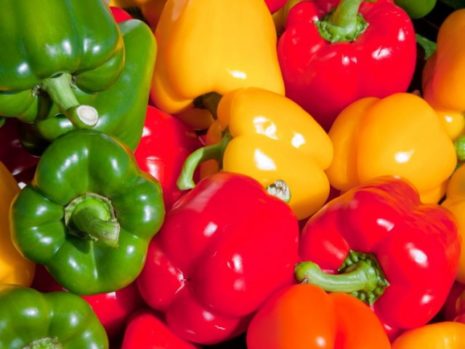

- Swallow. A versatile variety suitable for open and closed beds.
- The firstborn of Siberia. Has small fruits. The vegetable is used universally and adapts to any weather.
- Victoria. Pepper with a very delicate pulp. The variety is high yielding, disease resistant. Easily harvested for the winter.
- Alyosha Popovich. The skin of the pods is very thin, although the pepper grows in a cold region.
- The player is a very nutritious strain. Ripe pods are colored red.
A little about sowing seeds and caring for seedlings of early varieties
Sowing seeds for seedlings in Siberia begins by the end of February and beginning of March. To select high-quality grains, they are immersed for 10 minutes in a container with salt water and all floating pacifiers are thrown away. The good seeds remaining at the bottom are washed with clean water, disinfected with a manganese solution, and then, spreading them out on gauze, they are periodically moistened with warm water with the addition of a growth stimulator.
The hatched seeds are planted in 3 pieces in cups. It is better to buy soil from the store, but you can make the mixture yourself by collecting land from the garden. For disinfection, a glass of wood ash is added to the bucket of soil.
Each seed is buried 2-3 cm and all glasses are covered with a transparent film, after placing them in a warm place. Watering is carried out periodically as the soil dries, preferably by spraying. After the appearance of 3-5 leaves, the seedlings can be planted in the garden.
For better survival of seedlings, it must be planted in warm soil with a temperature of at least 20 ° C. Usually, a distance of 80 cm is maintained between the bushes, and 60 cm between the beds.
The video provides recommendations for choosing pepper varieties for planting:
Fat man
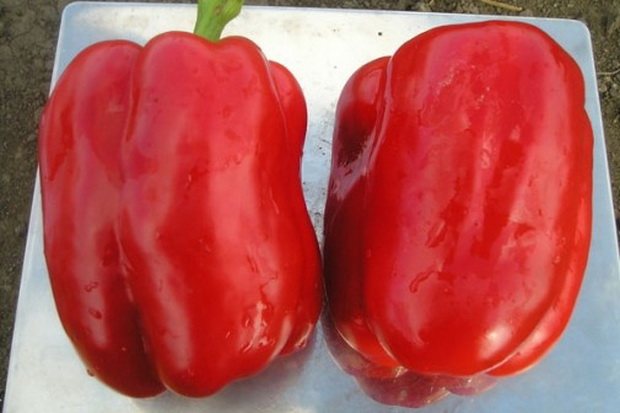

The name of the variety speaks for itself: the thickness of the pericarp of the fruits of this mid-ripening variety is 9-10 cm. The fruits of the plump are prismatic, with a pronounced glossy shine. Like the previous one, this variety is suitable for growing in beds and for greenhouse planting. The optimal period for planting seedlings is the end of May. The best yield is observed with a planting scheme of 40 x 60 cm.
Bushes of "fat men" are squat - 50-55 cm maximum, rather spreading. Under favorable conditions, up to 4.5 kg can be collected from one square. fruits. The qualitative characteristics of the fruits are as follows:
- pericarp - 7-10 mm;
- length - 10-12 cm;
- width - 6-8 cm;
- fruit weight - 60-130 g.
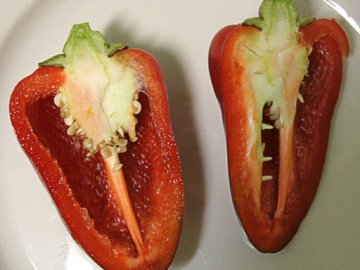

Medium early variety of pepper "Fatty"
The variety is not particularly capricious in its care: to ensure high yields, regular watering and a one-time application of mineral fertilizers to the soil are sufficient.
Common mistakes when growing seedlings
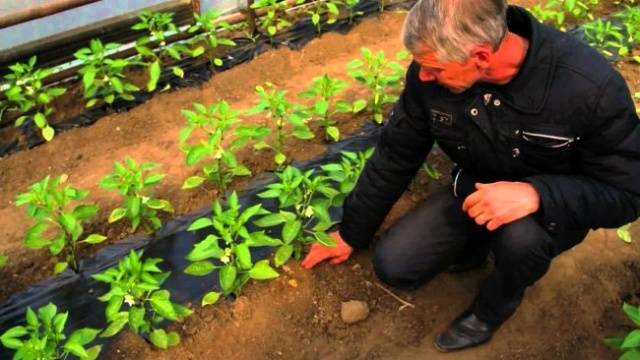

Inexperienced growers often make the simplest mistakes when growing seedlings, the result of which is a poor harvest or the death of the plant itself. Failure to comply with the temperature regime and growing seedlings in limited lighting will lead to the fact that the plants will begin to stretch. Planting on shady beds threatens with the fall of flowers, which will affect the amount of the crop or, in general, there will be none.
If a healthy-looking seedling with two full leaves suddenly stopped growing, it is urgently required to feed it. To do this, you will need to buy a complex fertilizer in a specialized store and pour the sprouts with a solution prepared according to the instructions. For the best germination of seedlings, the soil should always be slightly moist and warm. When all the seeds have sprouted, the ambient temperature is lowered for a couple of days to 18 ° C. This measure is necessary to harden the sprouts.
The video will tell you about the common mistakes in growing pepper:
Having chosen the varieties of early peppers you like, and observing the agricultural technology of growing crops, in Siberian lands it will definitely be possible to grow a good harvest of a heat-loving vegetable.
Diseases and pests
Despite the fact that many varieties of peppers for Siberia are easy to care for, they can still be exposed to diseases or some pests.
Rot is considered the most popular disease for open and closed ground, and aphids are considered a pest. Slugs, the Colorado potato beetle and the bear also cause great damage to the pepper. Among the common diseases of peppers are called late blight, septoria and black leg.
Serum helps with aphids. In order to prevent a bear against an hour before disembarkation, the holes are poured with water. It is necessary to pollinate plants with wood ash from pests 3 times during one season.
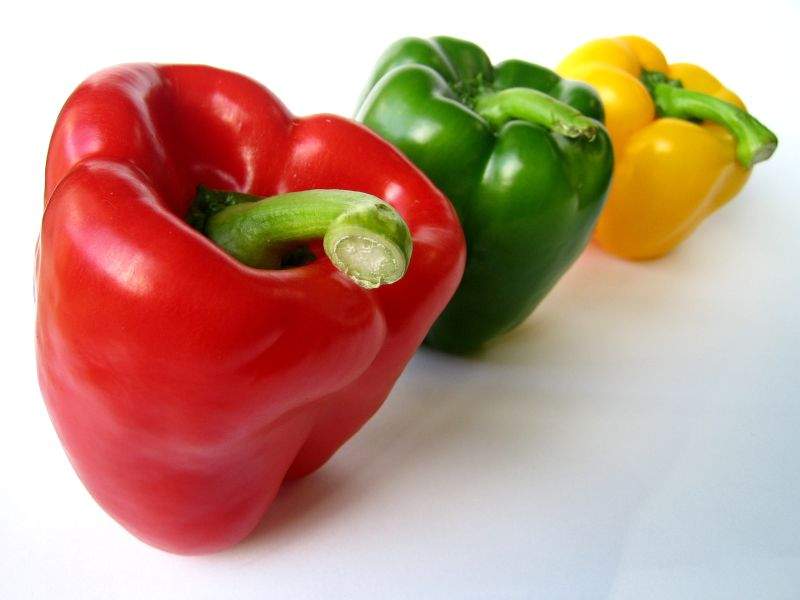

In the north of the country, there are rather harsh and unstable climatic conditions. Therefore, it is difficult to grow thermophilic vegetables there, for example, bell peppers. However, it is possible to achieve a high-quality harvest if you choose the right seeds.
An ideal option for the region is early peppers, whose fruits ripen even before frost. Let's talk about the most popular varieties of this culture for Siberia.
Pepper varieties of Siberian selection with photos and descriptions
Sweet pepper came to us from warm Mexico, and therefore has a special demand for temperature conditions. In the short summer conditions typical for Siberia, not every variety of this culture can be grown. In order to have time to collect the entire crop of pepper in this region, it is necessary to select early varieties. On this page of the site for beginner farmers you will find Siberian pepper varieties with photo and description.
Pepper of Siberian selection - short description, photo
The Siberian Prince is an early ripe, high-yielding, large-fruited variety of pepper (2 to 4 kg per 1 m²), the taste of which is described as very pleasant, and the color of the ripe fruit is red.
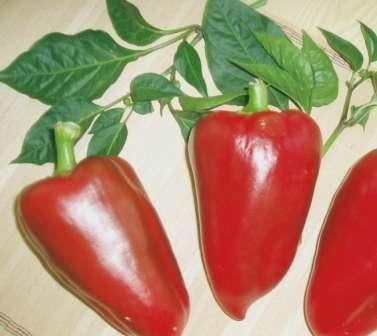

In the photo the Siberian prince pepper
The Siberian format is a tall and strong (half-stemmed bush) with large (up to 500 g fruits) of red color and delicate texture. Early variety. Up to 3.5 kg can be harvested from one bush.


In the photo, the variety of pepper Siberian format
Siberian felt boot is an early ripe hybrid with medium-sized, elongated, thick-walled fruits. This pepper is resistant to shading and low temperatures.
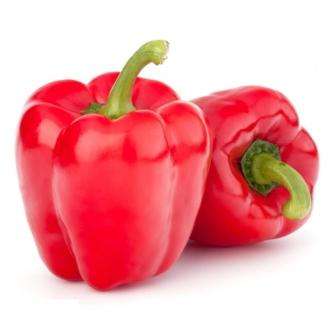

Vostochny bazaar is a mid-early variety of pepper, which is distinguished by the compactness of the bush and the red fruits of medium-sized prismatic shape and excellent taste. Productivity from 1 m² - 5 kg.
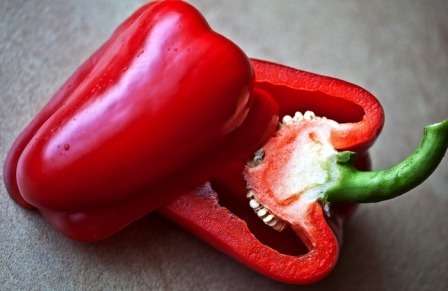

Pepper Oriental Bazaar
Siberian bonus - an early ripe hybrid of Siberian selection with thick-walled fruits of amazing orange color.Up to 15 peppers can grow on one bush, each of which weighs about 300 g and has a delicate structure and sweet taste with practically no bitterness.
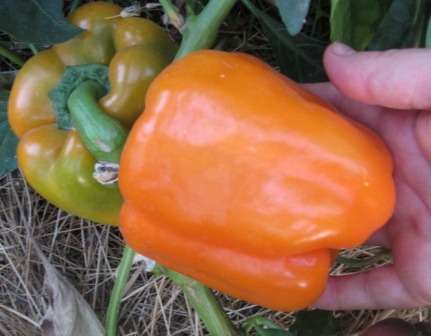

In the photo, pepper Siberian bonus
Tusk is a tall and early maturing variety of pepper loved by many inhabitants of Siberia. It should be grown on a trellis and led in two stems. Fruits are elongated, glossy, red, medium in size.
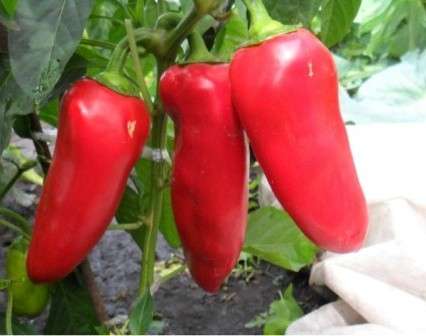

Pepper Tusk
The Golden Pyramid is an early ripening variety with medium-sized yellow fruits and excellent flavor. Resistant to temperature drop. In the open field, about 3 kg of fruit can be harvested from 1 m².
Viking is a red pepper, early ripening, with resistance to cracking and a rich vitamin composition. The fruits are medium in size, cylindrical in shape and have a mild flavor. A bush of medium height.
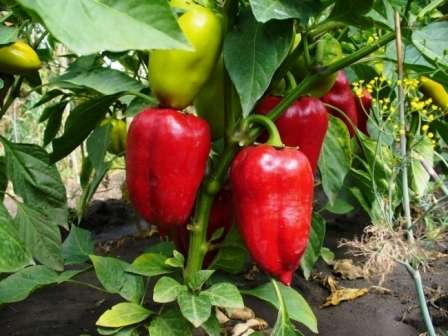

In the photo there is a Siberian pepper selection Viking
Mustang - has low spreading bushes, cone-shaped fruits of red color and pleasant taste. From 1 m² you can collect up to 3 kg.
The merchant is distinguished by semi-sprawling standard bushes and medium-sized red fruits that ripen early enough and have a sweet taste. This variety of Siberian peppers is resistant to changes in weather conditions and diseases.
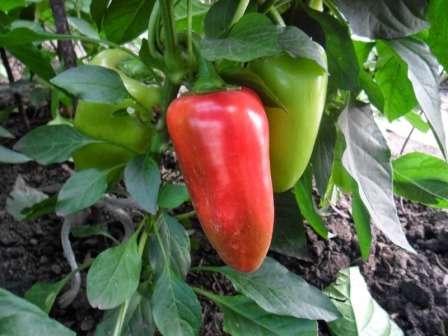

In the photo, the pepper variety Kupets
Apple Spas is one of the new varieties of pepper, created by Siberian breeders, which managed to win hearts. Small red cuboid fruits with very thick walls and amicable fruit return could not fail to please the agronomists. The pepper is quite mature, from one low bush you can get a harvest in the amount of 1.5 kg.
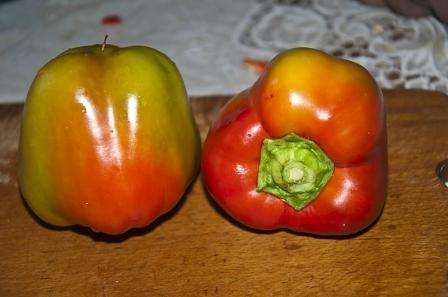

Pepper from Siberian breeders Apple saved
Novosibirsk is an early ripening variety with a low bush. The fruits have good commercial qualities and an extremely high content of vitamin C. From 1 m², up to 10 kg of red fruits can be harvested!
Pepper varieties of Siberian selection with photos and descriptions that you could find in this article will help you always have this most useful vegetable on your table. Even if you live in conditions that are not entirely suitable for growing sweet peppers, do not despair. Knowing the varieties suitable for your region will help you. If you cannot boast of a long and hot summer, then Siberian peppers are what you need!
Description of the hybrid: the origin and characteristics of the culture
Siberian felt boot F1 - pepper from the TM Uralsky dachnik seed catalog. There he appeared in 2020. There is no hybrid in the State Register. The manufacturer of the seed allows planting a plant in soils of various types in all territories of the Russian Federation suitable for agriculture. Growing methods: greenhouse or open bed.
Pepper is a medium-sized shrub with moderate branching and leafiness. The fruits grow wilted. Ripe specimens are large and fleshy. The thickness of the pericarp reaches 9 mm.
16 excellent varieties of plums for the Moscow region
The surface of the peppers is smooth. During ripening, the fruit changes color from green to uniformly red. The pepper is called juicy to taste. Its aroma is moderate.
| Growth type, bush height | Half-stem, 60-70 cm |
| Ripe fruit color | Red |
| Landing scheme | 40-50x70-90 cm |
| Weight, length and shape of the fetus | About 180 g, 14-16 cm, elongated cuboid |
| Ripening period, yield | Medium early (115-120 days). There are no exact data on the yield. |
| Drop off location | Flue gas / greenhouse / temporary greenhouse |
| Diseases | Resistant to ailments caused by a decrease in seasonal temperature |
| By type of use | Universal |
| Flowering type | Female |
The best varieties of sweet peppers of Siberian selection and the technology of its cultivation in Siberia
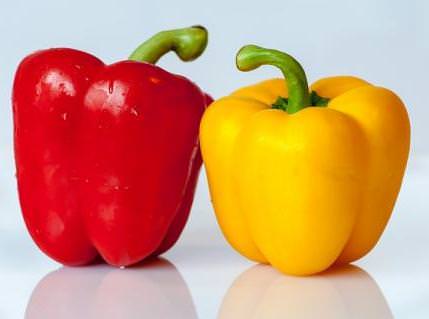

Sweet peppers are a thermophilic Mexican culture that, subject to certain conditions, can be successfully grown even in Siberia. For a short Siberian summer, early maturing varieties are best suited, which will have time to yield a harvest in a limited time.Also, when choosing seeds, you should pay attention to the packaging: many agricultural firms have whole series of vegetable varieties intended for growing in Siberia.
Features of the climate of Siberia
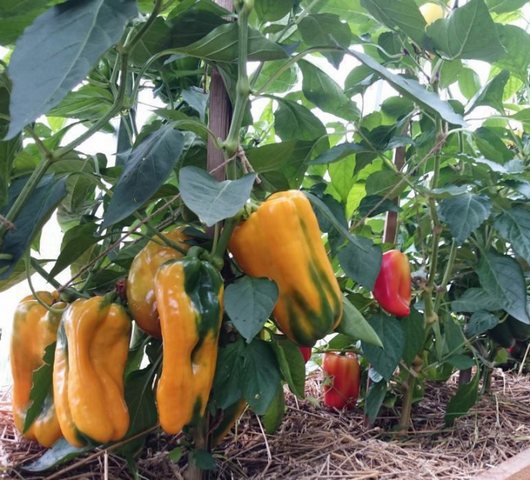

With proper agricultural technology, zoned peppers bear fruit well in the beds, foreign exotic plants with an unusual color are best planted in a greenhouse
Towards the center of the territory, the climate changes to sharply continental - summers are short and hot, winters are windy and frosty. Eastern Siberia is located in a cooler zone - winter is long, with severe frosts, and in summer it is much hotter than in the European territory of our country, dry winds and thunderstorms occur. According to local vegetable growers, it is difficult to get a good harvest of pepper here without a greenhouse.
The climate of Siberia is harsh, and the weather is unpredictable - this is a zone of risky farming. However, despite the inconstancy of temperature indicators, many experienced gardeners, thanks to the improvement of agricultural techniques for growing sweet peppers (abundant mulching, forcing in "warm beds"), achieve excellent results.
Sowing time and technology for seedlings
Peppers can be planted on seedlings at several times, starting from mid-February and ending on March 15. For this on the 20th of February, you need to soak pepper seeds in a growth stimulant, for example, "Zircon". A couple of drops are enough for half a glass of water. We leave the seeds in this solution for 8 hours. This soaking can significantly accelerate seed germination.
The swollen seeds can now be sown. For sowing, a loose and nutritious soil is prepared from equal parts of humus, sand, peat or sod land. You can also purchase ready-made soil mixture for seedlings.
Sowing can be carried out both in seedling boxes with subsequent picking, and in separate cups. Some vegetable growers make their own from paper. To do this, rectangular blanks are cut from the newspaper, which are then rolled into cylinders without a bottom. The side seam on them can be fastened with glue or a stapler. After the cups are ready, they are carefully filled with earth and placed in trays. Later, the seedlings are planted with them in the ground.
Fat Baron
This variety has a high yield (up to 7 kg of pepper can be harvested from one square). Pepper Fat Baron contains an increased amount of vitamin C (up to 155.7 mg per piece). The fruits are distinguished by a beautiful cone-cylindrical shape, the yield is 8-9 pcs per bush.
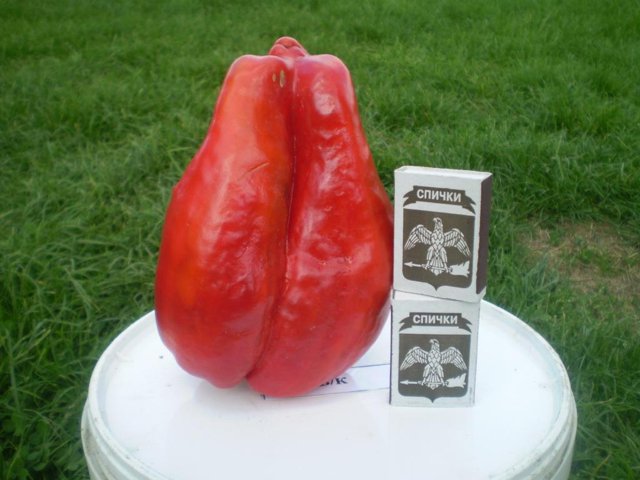

Fat Baron - pepper variety up to 245 grams and a meter high bush
Bushes of the Fat Baron are spreading, spherical, with thick stems. The height of the bush rarely exceeds 0.5 m.
The Fat Baron is one of the record holders for wall thickness (9-10 mm). The average weight of the fruit is 250-300 g, there are cases of growing specimens weighing up to 500 g.
The variety is early ripe (the period from the moment of germination until the fruits reach technical ripeness is 90-100 days). Disembarkation is carried out at the beginning of June. For maximum productivity, it is recommended to plant no more than 5 plants per square meter (3-4 is best). The variety is resistant to one of the most common viral diseases of sweet pepper - tobacco mosaic.
Seedling care before disembarkation
- If the sowing of pepper was carried out in common seedling boxes, then after 2 real leaves appear on the plants, it is necessary to start picking. You should not immediately plant seedlings in large containers. Before picking, the seedlings are well watered. Plants can be transplanted into peat pots, plastic containers, or homemade paper cups.
- During transplantation, you need to act very carefully and try not to damage the fragile stems of small peppers. They should be deepened by no more than 0.5 cm. Deeper planting will inhibit the growth and development of seedlings.
- During the week after the pick, do not allow direct sunlight to fall on immature plants. To do this, the window on which the crops are standing can be shaded with a piece of covering material, tulle or something similar.
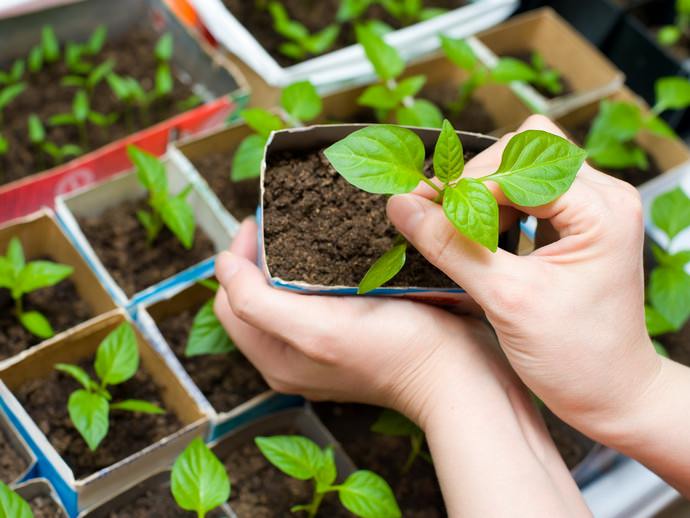

- At this point, it is very important to monitor the temperature of the soil. Under no circumstances should the boxes with seedlings be allowed to stand on a cold windowsill. This can provoke an outbreak of fungal diseases.
- The first watering after picking is carried out no earlier than 6 days later. In this case, it is necessary to evenly wet the entire soil. For irrigation, it is best to use settled water at room temperature. Watering is best in the morning, so that the surface of the soil has time to ventilate during the day.
- After 2 weeks from the moment of transplanting, you can carry out the first feeding. For this, you can use a mixture of humate and mineral fertilizer. After 10 days, another top dressing is carried out.
- If the seedlings are late in development, and their leaves are pale green, then you can feed them with nitrogen fertilizer, for example, urea. It can be applied both under the root and over the leaves. Dilute it according to the attached instructions.
Important! Experienced vegetable growers recommend periodically dusting the soil surface in containers with wood ash. This helps to avoid outbreaks of such a dangerous fungal disease as blackleg.
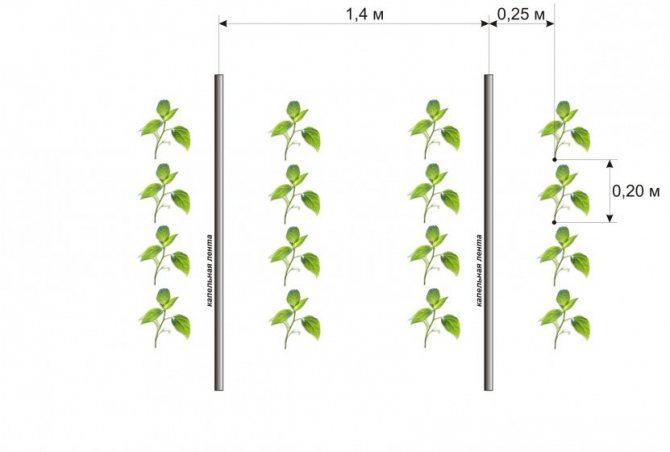

A month before the expected planting of pepper, you need to start hardening. To do this, seedlings are taken out on a balcony or terrace on sunny and warm days. In this case, the air temperature should not fall below 15 ° C.
When the seedlings reach a height of 20-25 cm, you can start planting it in a permanent place.
"Red Square"
It is classified as a super early species. The harvest can be obtained already 3 months after the appearance of the first shoots. Pepper bushes do not grow large. Their height is about 70 cm. Outwardly they look like a cube, inside which there are several partitions.
DETAILS: Wine or technical grape varieties: from which white wine and red wine are made
Basically, there are 4 partitions inside. The weight of one pepper is high: about 300 grams. Pepper reaches such a concept as technical ripeness in 2 months. By this time, the fruits are green. Having reached full ripeness, the fruits turn red. The wall of the pepper is thick, reaching a thickness of 9 mm. "Red Square" is very well stored and transported. The variety tolerates viral diseases very well.
Outdoor cultivation
You can start planting seedlings in open ground on the 20th of May. In this case, the beds with pepper will need to be covered with a layer of covering material, and a layer of film should be put on top of it. On hot days, the ends of the beds need to be opened. This shelter can be removed after the danger of return frosts has passed, in Siberia it is about June 13th.
In cases where cool weather is established, a layer of covering material can be left on the beds with pepper for the whole summer. It will protect the plants from the cold and create a favorable microclimate inside.
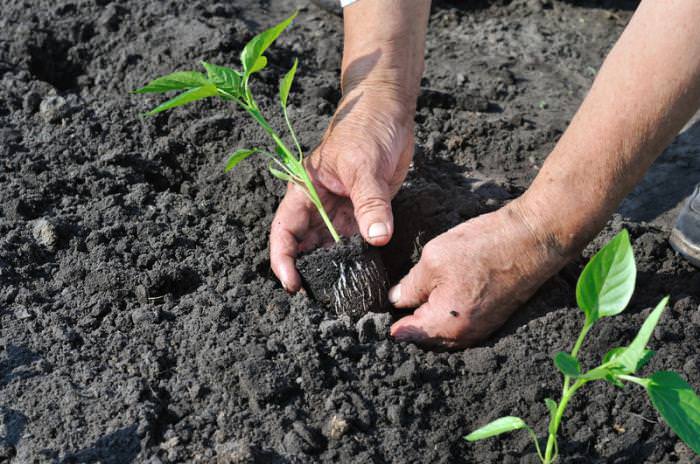

During flowering, peppers can be fed with ash. To do this, scatter a small amount of it under the bushes and carefully loosen the soil surface.
On hot days, planting peppers requires abundant watering. Depending on weather conditions, you can water up to 5 times a week.
Harvesting should be done as it ripens, as ripe peppers retard the further development of the ovaries.
Testimonials
“We do not have greenhouses, we grow peppers in the open field. We cover the vegetable only with non-woven fabric stretched over arcs. On the advice of my husband, I bought the so-called "Siberian series" of seeds. It includes the Novosibirsk variety and Pervenets Romantsova. I proceeded from the fact that since such peppers feel good in the cold, it will be even easier for them to grow in the central regions ”(Marina, Moscow);
“I am growing a classic Kolobok.The main advantages of this variety are easy transportation and thick walls. Pepper quickly turns red and tasty ”(Oleg, Novosibirsk)
In the absence of experience in the cultivation of greenhouse peppers in Siberia, at first, you may not get a bountiful harvest. Therefore, it is necessary to master the agricultural technology of this vegetable in more detail.
Agrotechnics in greenhouse conditions
The agrotechnology of growing pepper in a greenhouse is somewhat different from growing in an open field. Planting time in the greenhouse is the first days of May. Greenhouse-grown peppers also need to be shaped.
- To do this, within 10 days after transplanting, the lower leaves are removed from the plants before the first fork.
- Next, what needs to be done is to leave only two main shoots, and the rest need to pinch the tops. This technique helps to form the skeleton of a plant, consisting of two main shoots. Later, these shoots will need to be twisted around a trellis or tied to pegs.
- After the bushes begin to branch, in each fork it will be necessary to leave only one main shoot, and pinch off the tops of the rest. This procedure is repeated for each subsequent branch.
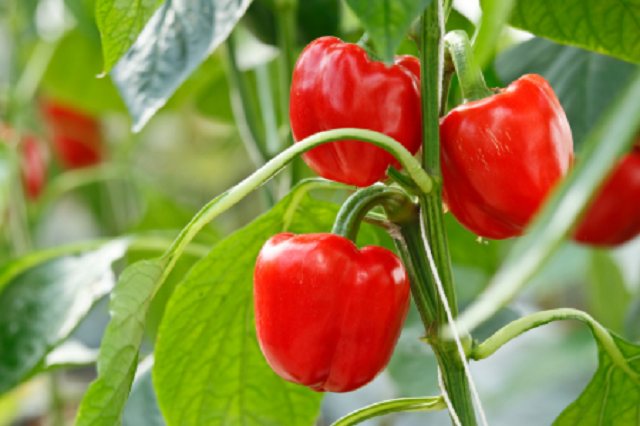

You also need to regulate the load on the plants and therefore the number of ovaries should be limited, while leaving 2-3 fruits. It is better to do this at the stage of the appearance of fruits, since when the buds are removed, the flowers left behind very often fall, and as a result, not a single fruit remains in the fork.
Greenhouse peppers require more intensive watering and feeding. It is especially important to bring them in during flowering and fruit setting. For root dressing, you can use ready-made complex fertilizers for vegetable crops, the leaves of the plant can be sprayed with a solution of trace elements.
The pepper has a superficial and rather weak root system, so it will have to be watered daily. Overdrying and subsequent abundant watering can lead to cracking of the fruit.
Growing features
So, in order to grow seedlings of pepper seeds, you need to sow them at the end of February. And before sowing in prepared soil, they should be subjected to the following treatment:
The peppers in pots are placed in the greenhouse, keeping a distance of at least 40 cm from each other. Don't forget about watering and feeding at this stage. They should be timely but moderate. The temperature of the contents should remain at the same level and be several degrees below the mark at which the seedlings begin their shoots, that is, about +18 degrees Celsius.
When the bushes start to branch out, you should start shaping them. Bell peppers in a greenhouse love to grow in freedom, especially if you do not want the thickening of the plants, you will protect them from many diseases.
When adult seedlings reach a height of 15 cm, the apical buds are removed. This has a good effect on the branching of the bush and the further development of the fruit.
Since peppers can be very high in heated greenhouses, you need to consider a garter. To do this, you can organize a trellis or homemade stands, tying plants in several places with special clips or several knots of thick thread to them so as not to damage the trunk.
It is necessary to constantly monitor the moisture content of the greenhouse soil, the temperature in the room, the humidity of the air and the condition of the plants, which in itself often shows what they lack, or excessively. When the temperature, air and feeding are normal, the peppers will grow well.
Read also: Mahonia holly: useful properties and contraindications
Outdoors
The temperature of the soil on which the peppers are planted should be at least 17-19 degrees Celsius. Usually, planting holes are dug for planting, the distance between them in the rows is about 0.6 m, and between the rows - 0.8 m.The peppers should grow freely, so do not plant them more closely:
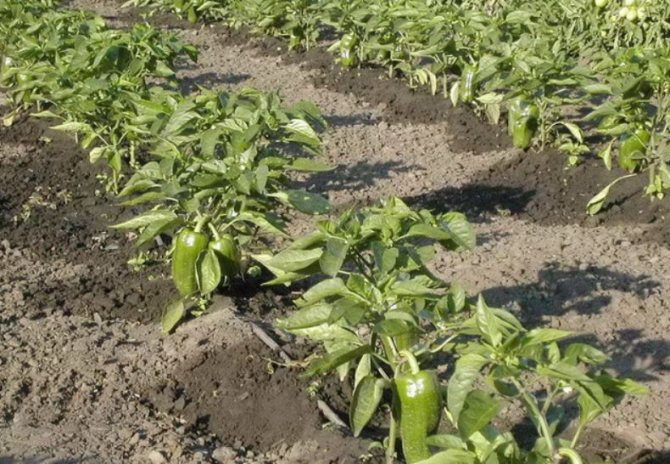

Further care for the pepper is as follows:
- regular watering (every other day), if there is no intense heat;
- loosening the soil up to 6 times a season;
- plant fertilization should be several times a season.
In the spring, fertilizers include phosphorus, potassium and nitrogen, and in the summer you can add organic matter, phosphates and potash fertilizers and exclude nitrogen.
You can also watch a video, where they will tell you how the bell pepper grew in Siberia.
The cultivation of pepper in Siberia is possible for almost all vegetable growers. The main thing is to choose the right varieties that are zoned for this region, follow all the instructions for growing seedlings, and then plant in a greenhouse or open ground.

